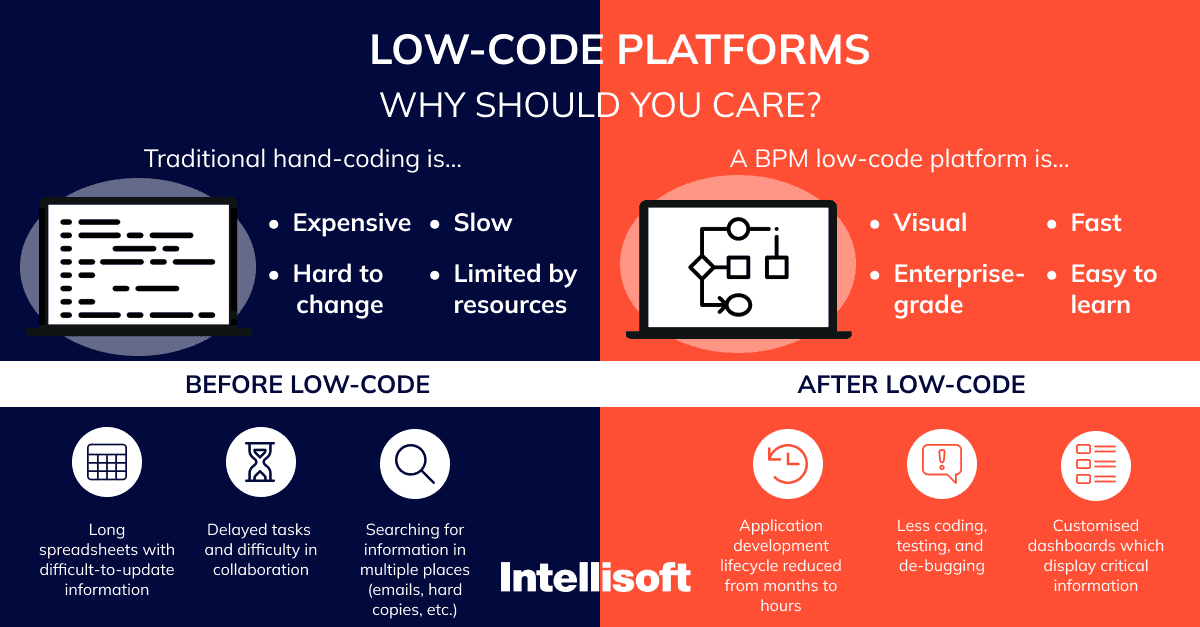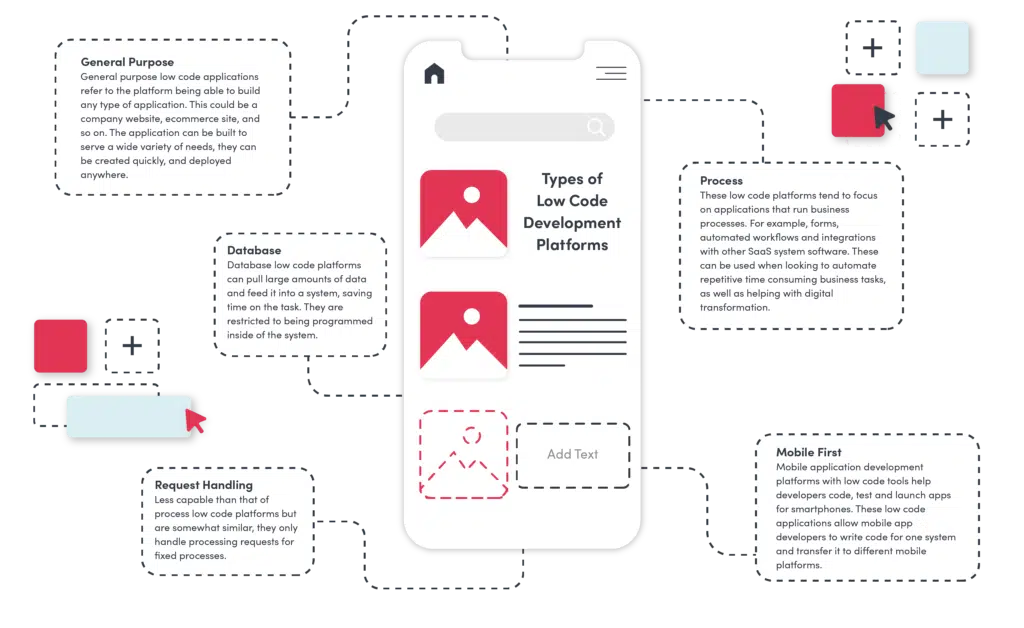Handy Reasons On Deciding On Legacy application modernization with Low-code
Wiki Article
In Terms Of Speed, Low-Code Applications Offer Many Advantages.
Visual Development Environment (VDE):
Drag-and-Drop Interfaces: Low-code platforms provide visual tools for designing applications. Drag-and-drop elements can be used by developers to quickly assemble apps without coding.
Many low-code platforms have already-built templates and parts. This allows developers to quickly develop or prototype their applications, without needing to start from scratch.
Coding needs that are reduced:
Automated code generation: Low-code platforms create the code base on visual models created and maintained by programmers. This means that there is less manual coding.
Reusable Parts: Developers will be able reuse reusable parts across different projects, and cut down on the amount of time needed to write and testing code.
Collaboration can be streamlined.
Low-code platforms come with a variety of tools that allow seamless collaboration between teams working on development. They can be used for version control, testing and deployment.
Citizen Development: Non-developers as well as business users can utilize simple interfaces to help in the creation of applications, which reduces bottlenecks caused due to a shortage of professionals to develop applications.
Rapid prototyping and rapid iteration:
Rapid prototyping. Developers can design prototypes quickly to validate their ideas and receive feedback. This will lead to a faster iteration cycle.
Easy Modifications - The visual nature low-code application development allows easy updates and changes, which speeds the refinement of applications based upon user feedback.
Pre-built Integrations:
API Integrations: Low code platforms are often pre-built with connectors to popular services and APIs. This cuts down on the time required to connect external systems.
Data Integration: Built-in tools for data integration simplify the process of connecting to databases and other sources of data which speeds up the development process.
Deployment and Scaling
One-Click Installation: Many low code platforms offer a single-click installation option which reduces the amount of effort and time needed to set up applications.
Cloud-Based Solution: Cloud based low code platforms are capable of handling infrastructure management and scaling. This lets developers focus more on applications' logic, functions and features instead of the logistics of deployment.
The primary benefit of developing applications using low-code, in terms of speed, is its capacity to automate and simplify many aspects of the development process. This allows faster delivery of applications, and faster adaptations to evolving needs. Take a look at the best Low-code Platform for application development url for site examples including push alerts, low code development platforms, cloud software applications, app modernization, develop cross platform mobile app, rad development, cross platform app dev, azure sql databases, application development platforms, application modernization software and more.

Benefits Low-Code Applications In Safety And Governance
Low-code development of applications offers a variety of advantages when it comes to security and governance, both of which are crucial to ensure that applications are compliant as well as secure and properly managed throughout their lifespan. Here are the benefits of low-code application development:
Unified Management Console (UMC): Low-code platforms often provide a centralized management console where administrators can oversee and manage all the applications to ensure a uniform governance throughout the entire organization.
Role-Based Access Control RBAC: These platforms have powerful role-based controls that permit administrators to set access rules. This ensures that only those with permission can modify or access certain parts of the application.
Compliance and Regulatory Conformity:
Many low-code platforms come with integrated compliance features. For example, they are built in line with the standards of the industry, regulations and laws (e.g. HIPAA, GDPR). They offer templates and tools to ensure that the applications are compliant with these requirements.
Audit trails and logging: Comprehensive audit trails and logging are often integrated. This lets companies monitor and track access and changes, and also ensure the compliance of internal policies as well as external regulations.
Increased Security Measures
Data Encryption : Low-code platforms usually provide data encryption built-in in transit and at rest. This ensures that data sensitive information is protected.
Security Certifications: A lot of providers of low-code have security certifications, such as ISO 27001 or SOC 2 which prove that they follow strict standards. These certifications provide additional assurances to users.
Automated Security Updates:
Regular updates and patches Low-code platforms typically are equipped to handle patches and security updates regularly. This ensures that applications remain protected from the latest security threats, and without developers having to manually intervene.
Security Monitoring: Continuous monitoring of security tools are typically used, which provide real-time alerts as well as insights into potential security issues.
Data Governance:
Data Access Policy: These systems help organizations define and enforce policies regarding data access, ensuring sure that only authorized users can access data and they are using it in a proper manner.
Data Masking and Anonymousization: The built-in tools to hide and anonymize data can help safeguard sensitive data in development and testing environments.
Consistent Application Management:
Pipelines for Development and Delivery: Low-code platform often include integrated development pipelines and delivery pipelines which incorporate security checks. Security is ensured throughout the entire lifecycle.
Version Control - Integrated version controls helps keep track of modifications to applications and allow them to be reverted, if required. They also help maintain the integrity and integrity of the application.
User Authentication Authorization
Single Sign-On (SSO). Support for advanced authentication and single sign-on makes it easier and improves security.
Multi-Factor Authentication Most platforms come with built-in multi-factor authentication, providing an extra layer of security to accessing applications.
Policy Enforcement and Compliance Monitoring:
Policy Templates: Low-code platforms usually have pre-defined templates for governance and security that enable organizations to quickly implement policies.
Tools for Monitoring Compliance These tools are able to monitor and report continuously on compliance status. They allow you to find issues and tackle them in a proactive manner.
Integration with Existing Security Infrastructure:
Seamless Integration: Platforms that use low-code have been designed to seamlessly integrate with the existing tools and infrastructure such as SIEM (Security Information and Event Management solutions) and firewalls.
API Security: Built in API security features protect information, guarantee integrity of the application and ensure safe integrations.
Training and Best Practices
Best practices guides: A lot of platforms have guidelines and suggested methods for developing secure applications. They assist non-developers in meeting security standards.
Certain lowcode companies offer resources and security training for users to learn how to create and maintain secure application.
Low-code development can provide a range of benefits for governance and security that ensure applications are developed and maintained in a timely way, safe and in compliance. These platforms include the tools and frameworks needed to oversee and manage application development processes, protect sensitive data while maintaining legal compliance and enforcing the policies. Read the most popular Legacy application modernization with Low-code tips for website info including cloud software applications, no code platforms, cross platform app development, app development platform, ms azure sql, azure sql databases, rad application development, app modernisation, driver jdbc, no code platforms and more.

Benefits Of Low-Code Application Development For Collaboration And Workflow
Low-code development has many advantages for collaboration and workflow. This is why it is a perfect solution for businesses looking to increase productivity and speed up the process of development. Here are the top benefits: Improved Cross-Functional Collaboration:
Unified Development Environment (UDE): Low-code platforms provide an integrated development environment that allows everyone on the team such as developers and business analysts to collaborate efficiently. They eliminate silos and encourage better communication.
Visual Development Tools Low-code platforms are straightforward to use, and come with the drag-and-drop interface. This allows non-technical members of the team to participate during the development process and ensures that business requirements can be captured precisely.
Communication Enhancement:
Real-time collaboration: A lot of low code platforms provide real-time communications features, including simultaneous editing and commenting. Feedback is instantaneously accessible. This reduces the amount of time needed to exchange information back and forth.
Shared workspaces. Teams are able to collaborate on shared workspaces. There, they are able to view, edit and debate various project elements.
Streamlined Workflow
Built-in Tools for Project Management: Platforms that are low-code usually have integrated tools for managing projects that help teams plan and track their development initiatives. This includes the assignment of tasks, progress tracking, deadline management and more.
Workflow Automated: The automation of repetitive tasks, workflows, as well as other processes reduces the amount of manual work required and eliminates mistakes. This lets teams concentrate on tasks that are more profitable and increases efficiency.
Faster Iteration:
Rapid Prototyping: Low-code platforms enable rapid prototyping and iterative development that allow teams to design tests, refine, and test applications in shorter cycles. This allows feedback to be quickly incorporated into the application as well as rapid enhancements.
Agile Development Support : Support of agile practices lets team members develop sprints. They can continuously deliver tiny increments of functionality and adapt more easily to changing requirements.
Accessibility for non-developers:
Citizen Development: Low-code platforms enable business users (citizen developers) to develop and modify applications without extensive coding knowledge. This helps IT and development teams to concentrate on other areas and react faster to business requirements.
Training and Onboarding. Intuitive tools and extensive training materials can help a new team members get acquainted, improving the overall level of collaboration.
Centralized Documentation, Knowledge Sharing and Information Sharing
Documentation is integrated: Low-code platforms are often equipped with tools to build and maintain documentation within the platform, making it simple to allow all project data to be centralized.
Knowledge Repositories: Teams can create and maintain knowledge repositories that include best practices, templates and reusable components, which aid in knowledge sharing and reducing repetition of efforts.
Consistency and Standardization
Standardized Components. The commonality of components across various applications ensures consistency, which helps to make it easier to work and understand by team members.
Governance and Governance and Compliance: Built-in governance frameworks ensure that all development is in line with organizational standards and regulatory requirements, reducing the risk of non-compliance and ensuring that applications adhere to quality standards.
Feedback and Improvement Loops
Integrated Feedback Platforms with Low-Code provide users with integrated feedback mechanisms that enable them to provide feedback easily on applications. The feedback is used in the development process.
Continuous Improvement: The ability of quickly iterating and deploying changes based on feedback will ensure that the software is continuously improved, aligning closely with the requirements and goals of users.
Visualization and Reporting
Real-Time Analysis Tools for reporting and analytics integrated into the software give instantaneous information about project progress, user interaction and performance. This allows an informed decision-making process based on data.
Visual Workflow Maps: Software for mapping workflows or processes are helpful for teams to comprehend their processes. They can also be used to pinpoint bottlenecks and areas that require improvement.
Low-code development has many advantages in regards to workflow and collaboration. It allows for the integration of diverse teams together, improve processes, streamline communication, and enhance teamwork. This encourages a collaborative environment with an agile and efficient process for development, which results in higher-quality apps and a better alignment between business goals.
